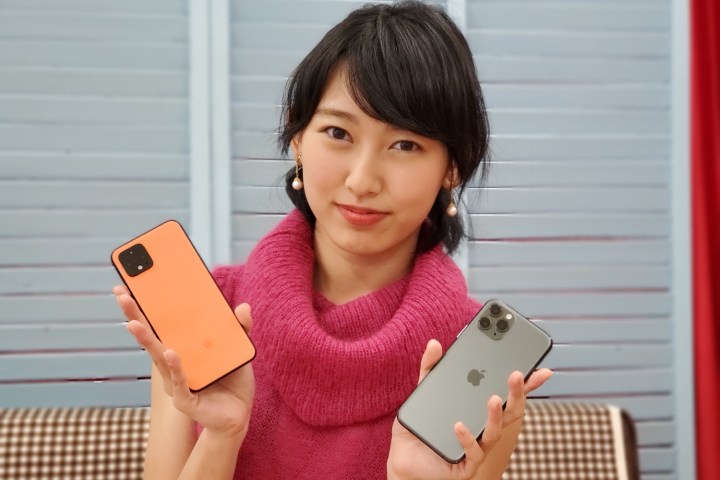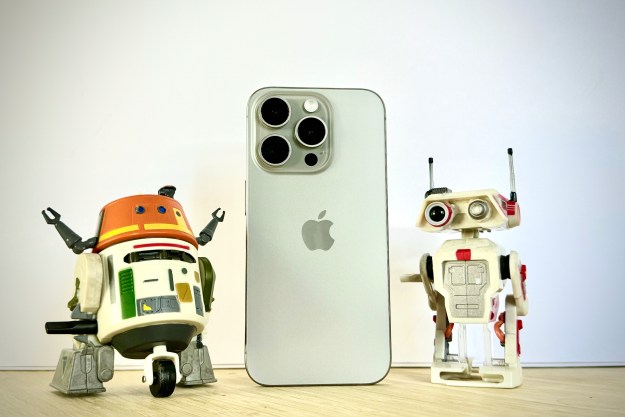
Is portrait mode on your camera really any good? What happens when you take a smartphone to a model photoshoot, for example, and try it out under pro-lighting and with someone who knows how to pose? That’s exactly what I found out on a recent trip to Japan, where I had the chance to take portrait shots of model and idol Ryoko Sakimura, with four different phones.
This isn’t the usual camera shootout. Normally, it’s the same photo taken back-to-back, and the results directly compared. People aren’t as compliant as landscapes, so each photo is subtly different, and each portrait mode works in a different manner too. Also, you can’t hand the phone to the landscape and ask it to try taking a photo, but for this comparison I could ask Ryoko to try out the selfie camera portrait modes to find out which one she liked best.
Here’s what happened.
The phones
The main battle was between the Apple iPhone 11 Pro and the Google Pixel 4, but when testing out the special portrait modes, I also used the Samsung Galaxy Fold and the Huawei Mate 30 Pro. As it turned out, this was a good thing.
Here’s a quick recap of what hardware is being used on each. The Apple iPhone 11 Pro has three 12-megapixel sensors — standard, 2x telephoto, and wide-angle — along with a portrait mode with a variety of different lighting effects. The Google Pixel 4 has two lenses on the back, a 16.6-megapixel sensor and a 12.2-megapixel sensor. It has a portrait mode, but does away with the flashy lighting effects found in iOS.
The Samsung Galaxy Fold has the same rear camera system as the Galaxy S10 Plus, meaning three lenses: A 16-megapixel ultra-wide sensor, a 12-megapixel wide-angle, and a 12-megapixel telephoto lens. It has a selection of different effects that manipulate the background in portrait mode. Finally, the Huawei Mate 30 Pro has three lenses too, a pair of 40-megapixel sensors, a 3D depth sensor, and an 8-megapixel telephoto sensor. There are a few different lighting effect modes available when using portrait mode.
Simple background
- 1. Apple iPhone 11 Pro
- 2. Google Pixel 4
Let’s start out with an easy one. The background in these photos is simple, and placed around a meter behind the model, with lighting both in front and behind the divider. At first glance, both are very good photos, but when you examine them more closely, a winner emerges. The iPhone 11 Pro’s natural skin tones are stunning, and Ryoko’s top is less saturated than in the Pixel 4’s photo; but the edge detection is not as effective.
Zoom in on her hair on either side of her face, and the Pixel 4 treats it as the foreground, while the iPhone 11 Pro gets confused, especially on the left of her face. The wisps of her hair on top of her head are blurred out in both photos, but the
Winner: Google Pixel 4
Parasol at a distance
- 1. Apple iPhone 11 Pro
- 2. Google Pixel 4
The parasol should either be part of the foreground, or part of the background. The camera can make the decision, but it really should be one or the other. The iPhone 11 Pro settles on the parasol being slightly blurred out, yet not quite so much as the divider further back in the image. It’s all very nicely handled, and with the iPhone’s typical natural colors and balance it’s a great photo.
The Pixel 4 can’t quite decide. Most of the parasol is in the foreground, but parts of the inside are blurred out, as are some of the tips, making it a less realistic image than the iPhone 11 Pro’s. The Pixel also doesn’t get her skin tone quite right, looking less natural than the iPhone’s attempt.
Winner: Apple iPhone 11 Pro
Parasol close-up
- 1. Apple iPhone 11 Pro
- 2. Google Pixel 4
Interestingly, the results are different when shooting at a shorter distance. Again, the iPhone 11 Pro’s skin tones, eyes, and colors are more attractive than the Pixel 4’s; but the detail in Ryoko’s top is greater in the Pixel 4’s photo. However, when we look at the bokeh effect, this time the Pixel 4 does a better job.
The Pixel 4 keeps the inside of the parasol in focus, along with Ryoko’s hand and the parasol’s shaft too. Then there is a subtle transition as the camera blurs the back of the parasol slightly. On the iPhone, Ryoko’s hand is blurred along with the majority of the parasol itself, and overall it looks less natural than the Pixel’s photo.
Winner: Google Pixel 4
Flowers
- 1. Apple iPhone 11 Pro
- 2. Google Pixel 4
There’s one major difference between how each of these cameras handled this shot. The iPhone 11 Pro decided to blur the flowers and vase slightly, while the Pixel 4 kept them sharply in focus. This seems to have an affect on the focus on Ryoko’s face too. The Pixel 4’s photo is slightly sharper, but the background color and skin tone is darker and less natural than the iPhone 11 Pro’s photo.
This shot was lit artificially and with some light from outside too, although it was a very overcast day. The white tabletop and white vase are beautifully captured in the iPhone 11 Pro’s photo, and it’s an overall brighter, more emotive image. It’s difficult to choose between them here, as both have strong upsides and serious downsides.
Winner: Draw
Flowers, by the Galaxy Fold and Mate 30 Pro

Let’s see how the other two smartphones I brought along handle this shot. The winner here is the Huawei Mate 30 Pro, which produces a stunning portrait shot that keeps the model, the vase, and the flowers in perfect focus, creating a sharp natural shot. Skin tones and color are closer to the way the iPhone 11 Pro handles the lighting, and the image really pops.
- 1. Samsung Galaxy Fold
- 2. Huawei Mate 30 Pro
The Galaxy Fold comes a very close second, but loses out by smoothing out her skin just a little too much, although the background is more effectively blurred than the Mate 30 Pro’s photo.
Winner: Huawei Mate 30 Pro
Special portrait effects

The Pixel 4 doesn’t get to contend here, as it does not provide any special portrait effects. Instead, the iPhone 11 Pro will take on the Samsung Galaxy Fold and the Huawei Mate 30 Pro, and there is a very clear winner based on the photos I took at the time. Above is an example of what the

The Huawei Mate 30 Pro didn’t do well at all. This is an example of the “Blinds” artificial intelligence portrait mode, which adds an unusual lighting effect by isolating the model against an AI background. However, it entirely misses the table on which Ryoko was leaning, and the chair on which she was sitting. This aside, if you cropped it down, the photo would become more acceptable.

However, the standout winner is the Samsung Galaxy Fold with its color-isolating mode. The result is very impressive, as it drains the color from everything except Ryoko herself. The effect is dramatic, the edge detection razor sharp, and both Ryoko and I loved the final look.
Winner: Samsung Galaxy Fold
Portrait selfies
- 1. Apple iPhone 11 Pro, Stage Light Mono selfie
- 2. Google Pixel 4
It’s all very well me wrangling the camera; but selfies are just as important, and using the portrait mode on the front camera can produce very different effects to the rear camera. Ryoko took a selection of selfies with each phone. I asked her which she preferred, and the answer was the Huawei Mate 30 Pro. Why? Because the 32-megapixel camera has a wider field of view than the others, allowing her to shoot more naturally from different angles, without stretching her arm right out.
It’s an interesting conclusion because when I look at the photos, it’s probably the one I’d put last on the list when judging it purely by portrait mode effect. While the background is softer, it’s not as blurred as I’d like, or as much as the other photos taken. Surprising, given the Mate 30 Pro’s 3D front sensor.
- 1. Samsung Galaxy Fold selfie
- 2. Huawei Mate 30 Pro selfie
The Samsung Galaxy Fold does a great job, with sharp edge detection, a flattering skin tone, bright colors, and that fantastic color-isolation mode active again. It’s the selfie I’d choose as the winner. Although Ryoko took several other selfies with the iPhone 11 Pro, the one with Stage Light Mono mode here came out really well, with the effect looking better here than the rear camera. I think this is a great photo. Finally, the Pixel 4 masterfully isolates her from the background.
The Huawei Mate 30 Pro takes the “model’s choice,” award, but arguably all took great selfies.
Winner: Huawei Mate 30 Pro
Conclusion
The Google Pixel 4 takes two wins and a draw when compared to the Apple iPhone 11 Pro, making it the overall winner; but it crucially misses out on a win in the selfies category, and doesn’t provide any special portrait effects either. The
What does our test prove? That for now, regular portrait mode shots on any of our phones tested here produce excellent photos, while the special modes are for the most part gimmicky and unreliable. Finally, thanks to Ryoko Sakimura for her patience on the day, as she had to pose for four different cameras, every single time.
Editors' Recommendations
- A big iPhone update is right around the corner
- One of the most iconic iPhone accessories is back — and it’s great
- iPhone 16: news, rumored price, release date, and more
- 5 phones you should buy instead of the iPhone 15
- The first Google Pixel 9 Pro hands-on photos are here

















